Well here we are in November, Hallowe`en is over, and I have caught a cold, the first for many years. Also my new canine companion is far less laid back about fireworks than any of the others have been. The solution seems to be the radio, or YouTube, which, if I pick a selection of the most rousing tunes, especially ones I like, and crank up the volume to full blast, seem to cover all but the largest bangs - except for the fact that these always seem to come in the spaces between the music. And hopefully you are finding a way to get your four legged friends through it too?
This week has been a bit chaotic. I start each week with a blank sheet on which I write the dates, then faithfully record the subjects I have used before under each. Then the hunt is on for different things to those to talk about. I start with November 1924, to give me the Centenary cards, and as I spot something interesting I write it in, until all days are filled - of course the Centenaries are not always there, and so then the net gets cast wider. Then I cross check that the dates are right - and there are a lot of times when they are not. And then I start to look for the cards, and ask about if I draw a blank. Now sometimes it is a fairly clean sheet by this stage, with just a subject, a tick to show the date is right, and a circle to show that I have a card. This week, I can only say it is a mess. I only had two days of the week where the subject was correctly dated and I got a card out of my box. On Thursday of this week I was still really struggling with Wednesday, I had crossed out three subjects and found no cards for the fourth.
Anyway, enough kvetching. And let me present a sip, a split, a Strauss, some stir-fry, a saxophone (though it was only added at 2pm this afternoon), a statesman, and a Stoker....
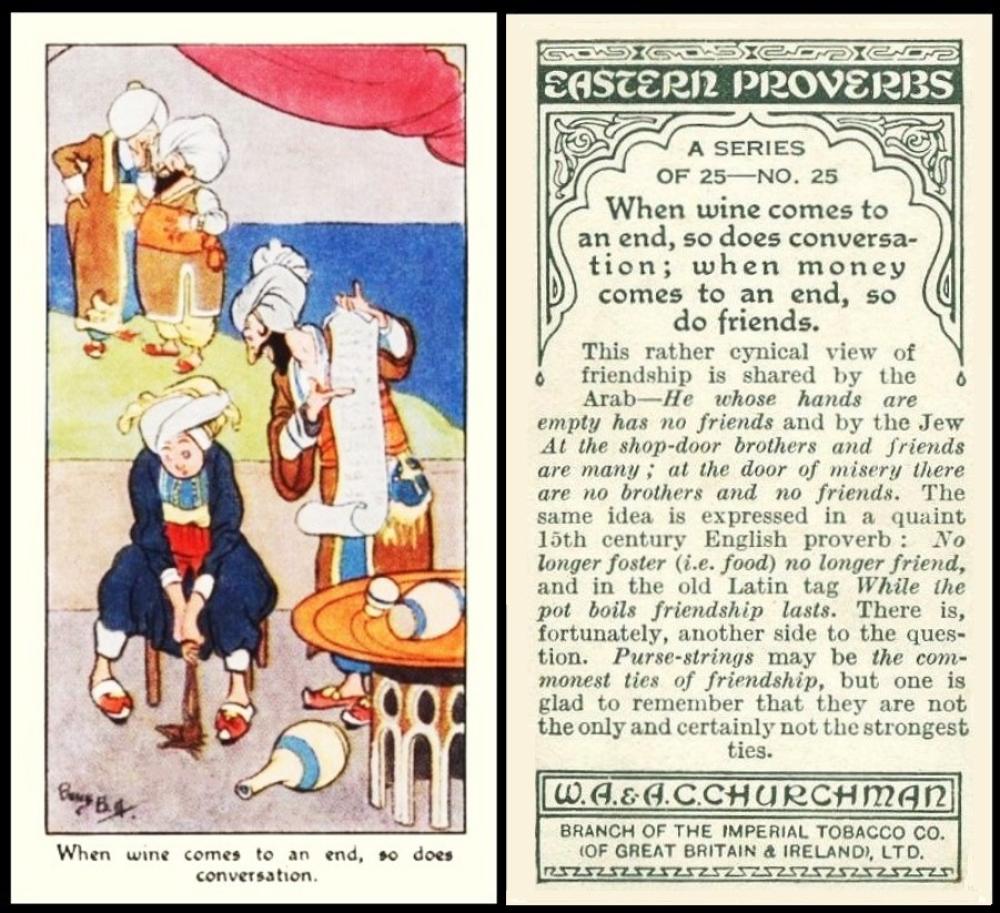
W.A. & A.C. Churchman [tobacco : UK - Ipswich] "Eastern Proverbs" first series (August 1931) 25/25 - C504-470.A.1 : C82-44.A.1
Today in 1924 saw the first crossword published in Britain - or so I wrote on Sunday night. I then only found one card of a crossword, a Liebig card that I had used before, when I wrote about crosswords. If that was not bad enough, I then found out that this was actually not the first crossword in Britain anyway, that honour having gone to the one in Pearson's Magazine in February 1922 - the 1924 one was only the first in a newspaper, namely the Sunday Express.
Moving swiftly on, I then found out it was National Wine Tasting Day. However cards of wine are non existent - or maybe the tobacco companies didn`t like any other vices competing? I found this one though, which is rather fun, though the back was a bit stained and needed tinkering. The theme is "When wine comes to an end, so does conversation". It`s kind of a play on the fact that those who you think are friends are only really with you whilst you are plying them with wine or gifts. The back of the card tells us that this thought appears in many different religions and customs - Arabic, Jewish, British and Latin - but probably all people, in all countries in the World have found this out anyway, to their cost, in more ways than one.
A wine tasting is rather a grand event, and the idea is take time to consider the colour, and then just to have one sip, which you are supposed to feel inside of your mouth and then discard. As a non drinker, I have to say it does not sound very exciting. Perhaps it is designed for those with grander tastes than me, in every way. And perhaps it was thought to have been a bit too highbrow for the tobacco companies too.
Anyway we have featured the second set of these cards before, in our newsletter for the 29th of April 2023, as the first card up on Saturday the 29th April. So I am glad to be able to finally add this, its partner. However there were also four sets each of twelve large sized cards, only one of which we have featured yet - though I have no idea when as I can`t find it.
Our original Churchman reference book RB.10, from 1948, describes this first series as :
40. Aug.1931. 25. EASTERN PROVERBS. (titled series) Size 2 11/16 x 1 7/16 or 67 x 36 m/m. Numbered 1-25. Fronts printed by letterpress, 4-colour half tone process. Backs in dark green, with descriptions. Printed by Mardon, Son & Hall. Also issued in New Zealand by Ardath Tobacco Co. Ltd.
Details of this New Zealand version appear in our handbook under Ha. 521 where it tells us that they were a series of 25 small cards. It also appears in our original Ardath reference book, RB.6, issued in 1943, where it is described as "Similar to Churchman`s Eastern Proverbs, 1st. Series"
In our original World Tobacco Issues Index our Churchman set is described as :
EASTERN PROVERBS. Nd. See Ha.521. ... C82-44
A. Small - (1) "A Series of 25" (2) "2nd Series of 25"
B. Large - (1) "A Series of 12" (2) "2nd Series of 12" (3) "3rd Series of 12" (4) "4th Series of 12"
It is the same text in our updated volume, but has a new code, of C504-470.A.1
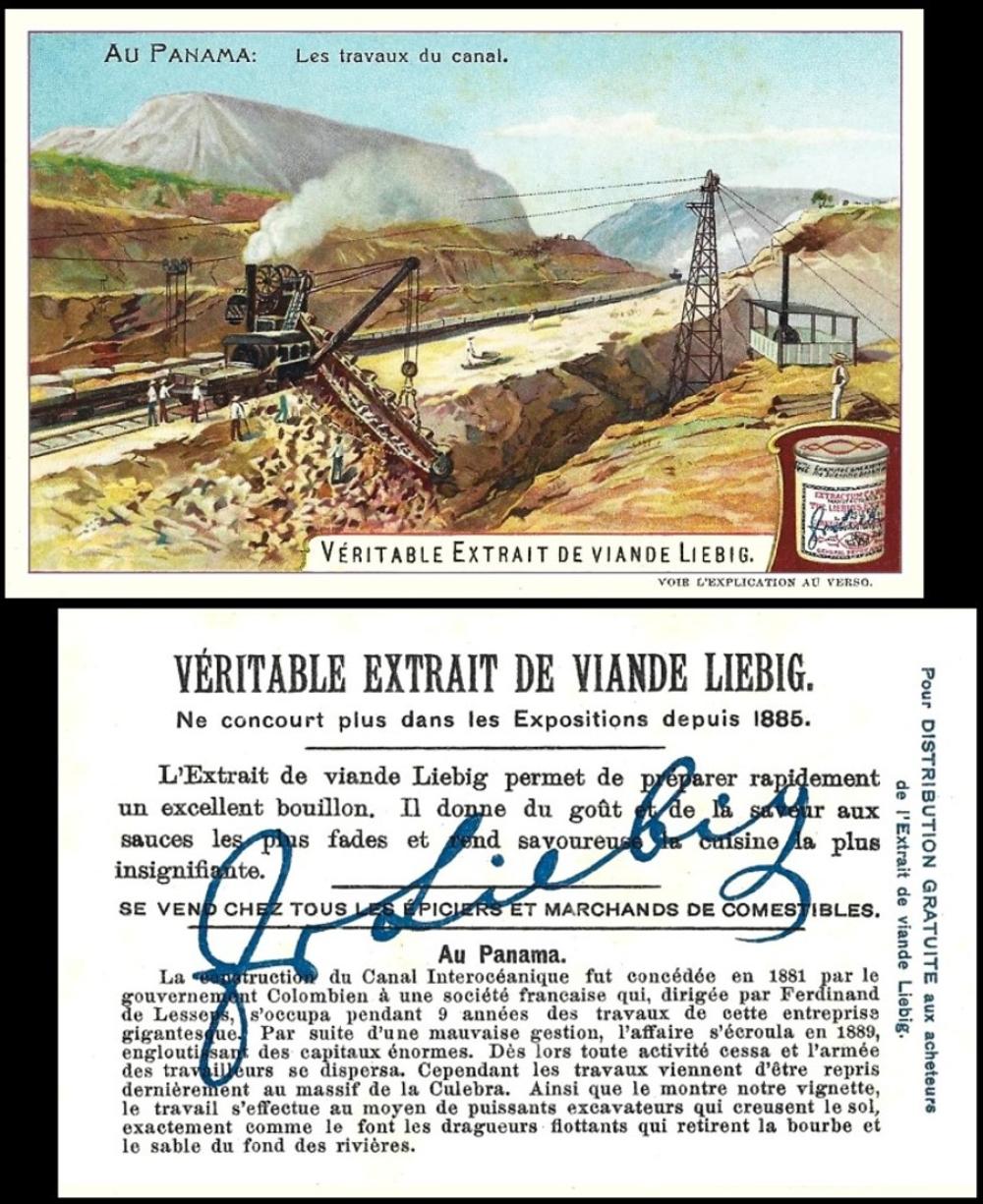
Liebig [trade : meat extract : O/S - South America] "Au Panama" / "At Panama" (1905) F.0834 : S.833
This is one of the two cards that I got straight away, and it marks the splitting of Panama from Colombia, in 1903..And, strangely, though you may not realise it, this canal directly involves this event.
It all started in 1850, when America and Great Britain sat down and negotiated a scheme for them both to take part in building a canal in Nicaragua, Central America . Before this, there had been rival plans drawn up by both countries but for more or less the same area.
It was the French which had the idea of building a canal in Colombia. Their canal was much further along on the plans and they even had an architect, Ferdinand de Lesseps, who had already built the Suez Canal in Egypt. And before the British and American canal had ever left the planning stage the French had started to build theirs, in Colombia - though this was not until 1880.
They soon found out that this was going to be a much harder job than they thought, and the men soon fell foul of all manner of tropical diseases, thousands of them dying before the scheme went completely bankrupt in 1889. At this point the Americans decided to step in and build their own canal after all, in the same place, and using much of the deserted workings left behind by the French. However Colombia did not like this, and the American offer was turned down. The Americans did not like that, and went to war. The first thing they did was to send warships down to the area, ostensibly to support a desire for Panama to become independent of Colombia. Colombia was not too keen on this, and so they started up country to head the American invasion off, only to find that the jungle was too thick. When their forces also started to become affected by sickness they admitted defeat, and allowed Panama to have both the land and their independence.
Shortly after that America signed a treaty which allowed them to have a strip of land that included the abandoned French canal in exchange for ten million dollars up front and a quarter of a million dollars a year ever after.
However one thing I did not know is that as the Millennium struck, the Canal was given by its former owner, the United States of America, to Panama.
In fact the Canal was not opened until 1914. It runs for just over fifty miles, and connects the Pacific Ocean with the Atlantic Ocean, saving the treacherous, and time consuming, journey right down to the bottom of South America and back.
This set is actually called "Au Panama" which means "at Panama". It is F.0834 or S.833, depending on whether you are a Fada fanatic or a Sanguinetti supporter, and it comprises various scenes of the area - our card of the Canal being dug, the railway at Colon, a local dance, a view of the town of Panama (now Panama City), a small child modelling a Panama hat, and a card which shows the flag, the Christopher Columbus statue and the Cathedral. There are several versions, the most inexpensive, under twenty euros, being from Belgium, France, Germany, Italy - the first two of which have this same title, of "Au Panama", whilst the Italian cards are "Ai Panama",.and the German "Bilder aus Panama" which translates to Pictures of Panama. Then there is the more expensive one, from the Netherlands, entitled "Zichten uit Panama", or Sights from Panama - and that often sells for three times as much.
Now do note that there is another set, issued later, in 1918, which also shows the Canal. This is F.1092 or S.1086, and it was issued in Belgium, Germany, Italy and the Netherlands. The Belgian and Italian sets can be picked up for about fifteen euros, but the German one is scarce, and might set you back a hundred euros - whilst the one from the Netherlands is valued at double that. Curiously, it starts with three cards of the construction, followed by three cards of it in use. but these are all new cards, they did not reuse our image - and so I imagine that ours is probably absent from many collections of the Panama Canal.
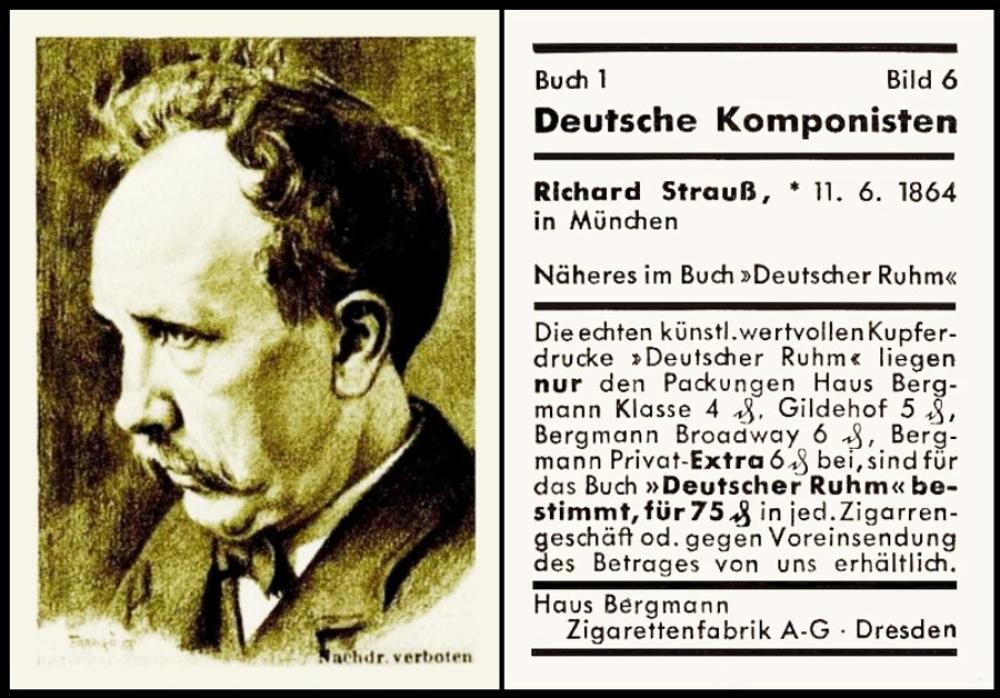
Haus BERGMANN Zigarettenfabrik A-G [tobacco : O/S - Dresden, Germany] “Deutscher Reum” / “German Fame” (19??) B317-275 : B67-8.8
So to another of the disasters - though to be honest I stuck grimly with Richard Strauss for a very long time before I even found a card. Then, on Thursday night, I noticed that the name on the card I had found was Johann....
Luckily, on Friday, someone found me this card.
The reason he is here is not because it was his birthday, but because today, in 1924, one hundred years ago, his opera "Intermezzo" was first performed, at the Dresden Semperoper. This is a comic opera, in two acts. The story depicts two people, a man and a woman, called Robert and Christine Storch, plus their son, members of their household, and friends - and only when the performance started did Mrs. Strauss find out that she was Christine, or rather that things that had happened in their marriage were suddenly being aired, for amusement, in front of an audience. Reportedly she was not so amused.
Strauss seems to polarise opinion. He was born in Munich on the 11th of June, 1864, to a musical family, for his father was in the Court Opera, and also a respected professor at the Munich Conservatoire. He took his son with him, and to occupy him, he allowed him to have mock lessons from orchestra members whilst they were not on stage. All agreed that the young boy was very talented, and he was allowed to compose music from the age of six. He produced many works in his youth, and most of them met with acclaim; and so he was asked if he would like to tour America, including a chance to conduct at Carnegie Hall. This was also a huge success, though it was not all fame and glory, for he spent a lot of time working on an opera, an adaptation of the play "Salome", written by Oscar Wilde. This was first performed in 1905, and though it was popular with many, there were others who were not so pleased with the subject matter, or that it was associated to Oscar Wilde. He would later also rebel at the outbreak of the First World War, when he refused to sign a manifesto that declared all German artists must support the war. And as the Second World War approached, he found himself again conflicted, for his son was married, to a Jewish girl, and they had two sons. He spent the war treading a very fine line between rebellion and grudging support, and though his immediate family survived, with deprivations, many of his in laws were killed
He died in his sleep, of complications resulting from a heart attack, and prolonged bladder and kidney failure, on the 8th of September 1949. His wife survived him by just eight months.
The first thing that needs sorting out is that this set is listed in the original World Tobacco Issues Index under another name – where the entry reads :
DEUTSCHER REUM (German Fame). Sm. 60 x 42 and Lg. 84 x 59. Sepia. … B60.7
1. “Buch 1”. (100). Two backs (a) with (b) without trade mark in centre. 10 sub-series, Nd. 1/10 each and commencing with word “Deutsche”. 8 small, 2 large in each sub-series.
1. “Bildhauer und Maler”
2. “Dichter u. Schriftsteller
3. “Erziebeher u Rechtslehrer”
4.“Helden der Luft”
5. “Helden der Marine”
6. “Helden der Landheeres”
7. “Kolonisten und Geschictsforcher”
8. “Komponisten”
9. “Nobelpreistrager”
10. “Staatsmanner”2 “Buch 2”. Nd. 1/100. Part small part large.
I am unsure why there is such a lengthy description of book one, but such a brief one of book two. But I will try and investigate
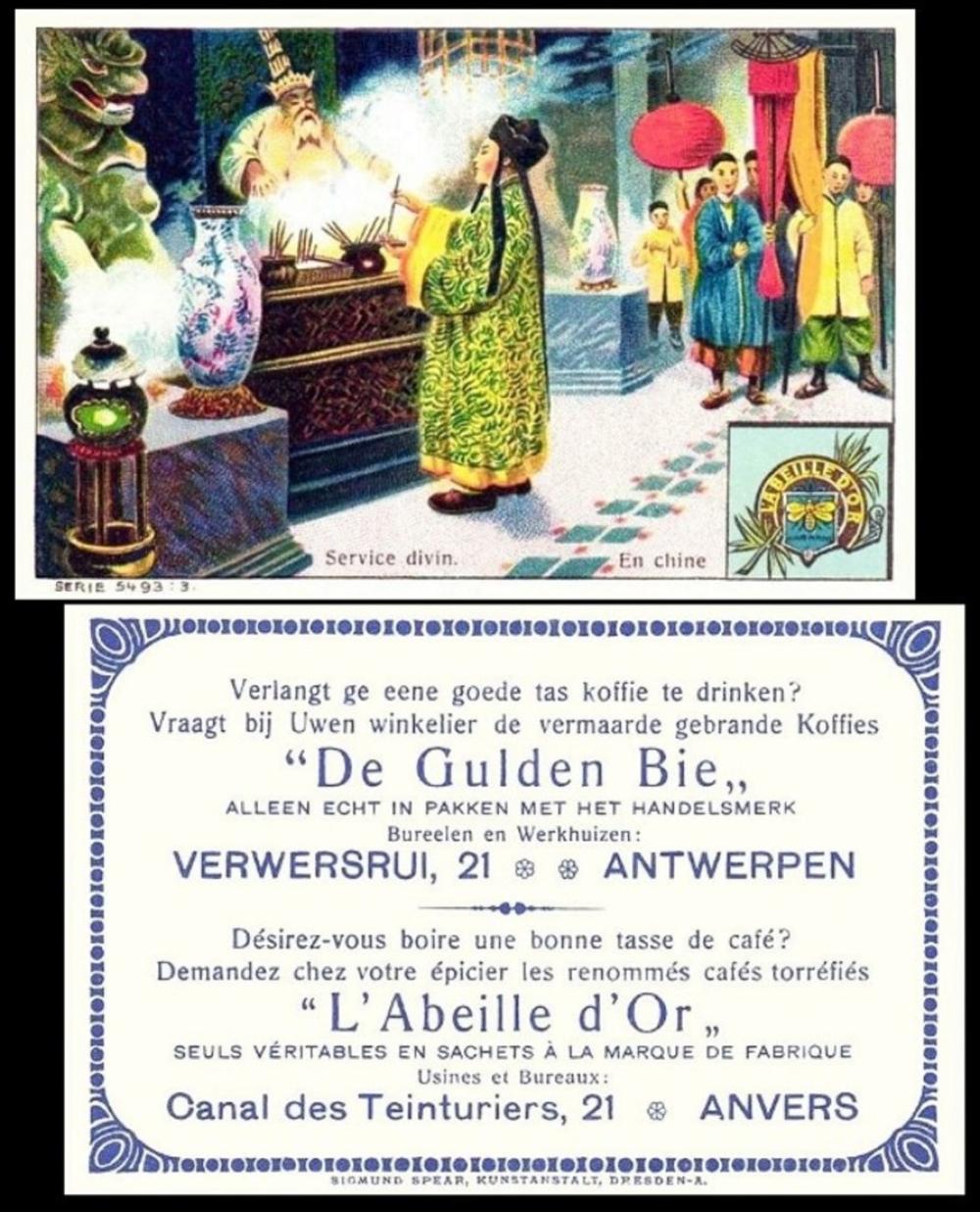
Adolphe Huybrecht [trade : coffee : O/S - Holland] "En Chine" / "In China" (19?) Serie 5493 - card 3
So this date started out as the birthday of Joel McCrea, but all the cards I could unearth came from sets I have used before. Then I found that it was National Donut Day, but even knowing that they are Homer Simpson`s favourite food did not get me any closer to a card...
So we have ended up with "Chinese Take Out Day", and a most amazing card, so atmospheric and I can smell the aromas. Ir also reminds me of the street market in the original "Blade Runner" film.
Sadly then on further research I think this is not a restaurant, it is a temple. What I took for chopsticks and steaming delights being incense burners and joss sticks. However I am willing to hold firm to my original thought, and I hope you will do the same?
As for the clue which gave me this correction, it is the title of the card - "Service Divin" - "Divin" either meaning fortune telling, or religion.
Now there is quite a tangled tale about this card, and you will note the back is in two languages, one for a brand called "De Gulden Bie" in Antwerp, and the other being "L`Abeille D`Or" in Anvers. Both these actually mean the same thing, the golden bee, and if you look a little closer it turns out that both these addresses are at number 21.
What has actually happened is that Antwerp is split into two sections, the Dutch section calling it Antwerp, and the French side calling it Anvers, and so this card can be printed as a bulk lot, and then circulated in both areas.
This card was actually issued by Adolphe Huybrecht, a coffee roaster, at the sign of the golden bee, and they moved to number 21 in 1854. It was a place famous for artists, in fact the name of the street means "the Painter`s brook" and comes from the fact that they would come out of their studios and rinse their brushes in the river. The golden bee seems to have been both a coffee house, where the artists could entertain their clients, rather than having to clean up their studios, and a place where they could buy ground coffee to drink at home.
Some collectors also swear that the shop was called the Cafe Torrefies - but that simply translates to roasted coffee.
I do not know how many are in the set, but I suspect there might be six, which seems to be a common length in Europe. However the only other one I have seen is called "Peintures sur Porcelaine" and that is card 5.
If anyone has any more I will happily record them.
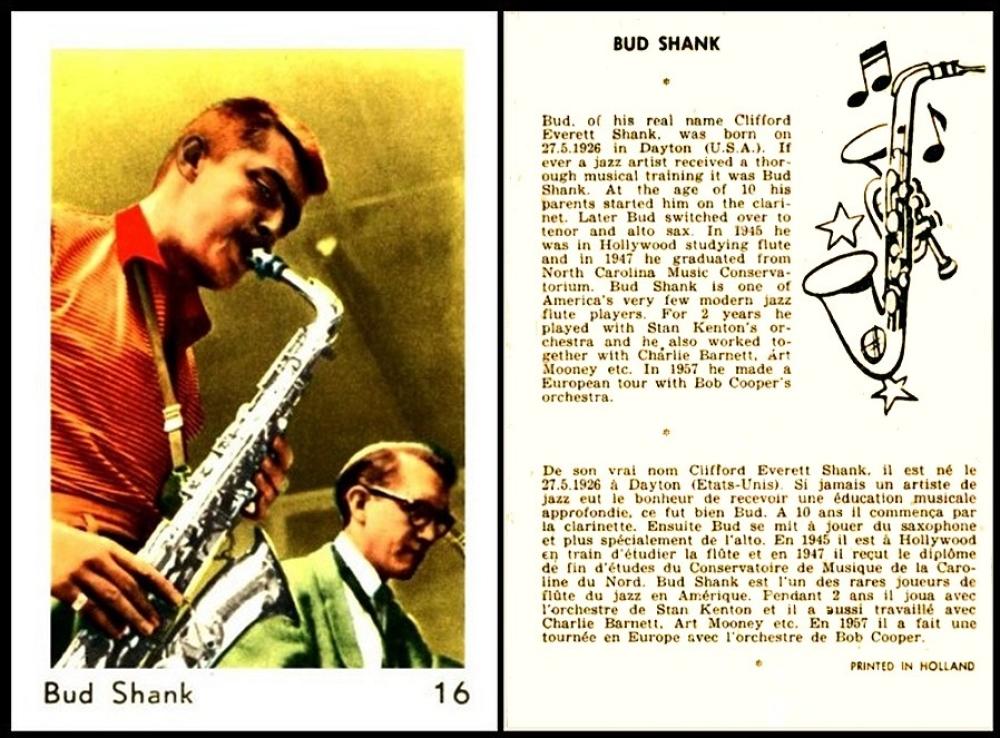
Maple Leaf [trade : gum : O/S – Holland] “The Saxophone Set” / “The Sax Set” (1959) 16/50
This was the day that caused all the problems. I failed with the first three events I found, one had the wrong date, one had no cards, and one I had used before.
Then I discovered it was Saxophone Day, so the hunt was on again. And we have found a great set, which not only shows a saxophone on the front, but on the reverse. In fact this set is named as it is because every card of the fifty in the set has a saxophone somewhere on the reverse - though many of the artists on the other fronts have nothing to do with that instrument.
The only problem was that the backs were very hard to work with, the board is grey and the text light, so if you try to make them lighter the words disappear. It is available in three colours though, blue, which I never found, red, the least said about the better, save it was very blurry, and this, described as black but not very dark at all, grey might be a better term for it.
One thing I must tell you is that our saxophone player only ever appeared in this set, so the three cards stated for him on the Trading Card Database/SaxSet are the colour variations.
His name was Clifford Everett Shank Junior, and he was born on May the 27th, 1926. He started off playing the flute and then shifted to the saxophone, though he could pretty much play anything. He moved to Hollywood later in life, and became a studio musician, which he much enjoyed, saying that every day was different. It allowed him to take time off to appear with orchestras, though he always regretted that he was unable to take up the offer of playing with Duke Ellington.
He also wrote music for many soundtracks, and appeared in the background of some of the greatest hits of the time.
He died on April 2, 2009
One thing I must point out is that European collectors are often sketchy, to say the least, about what instrument actually appears on cards. If you are after a stated instrument, it is always advisable to ask for a picture before you buy.
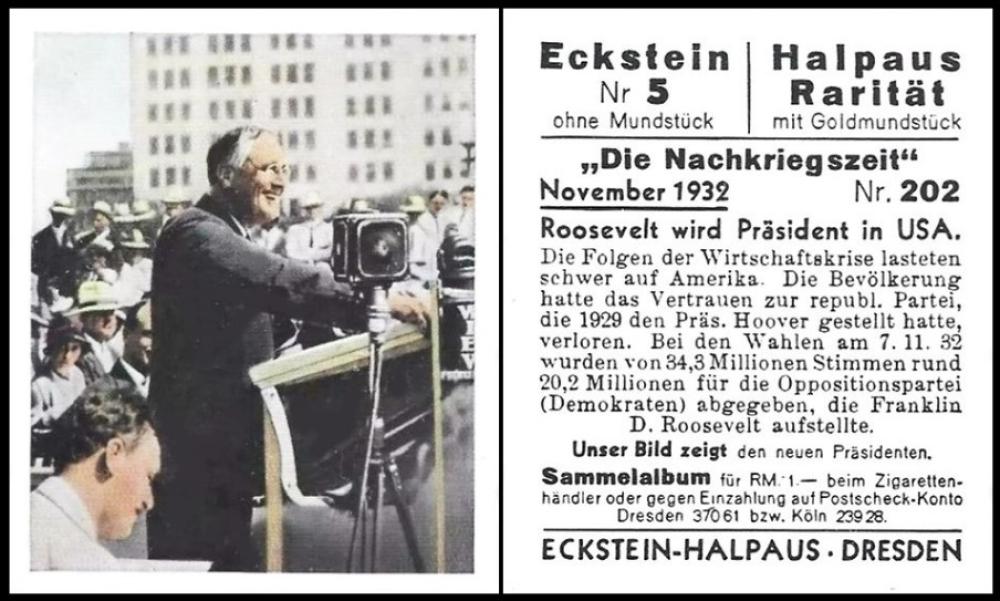
ECKSTEIN-HALPAUS Cigarettenfabrik G.m.b.H [tobacco : O/S : Dresden, Germany] “Die Nachtskriegzeit” / “The Post War Period” (1930) 202/280 – E165-550 : E10-8 : X24/15.A
So here we have Franklin Delano Roosevelt , who, today in 1944, won his record fourth Presidential election, though he did not actually formally take office until January the 20th, 1945.
His third election win was unprecedented, and was only managed when he pled a very viable case that between the Great Depression and the start of the Second World War it would be too much upheaval to suddenly have a new man on the job.
No American President had ever served four terms before, or has since.
Eckstein-Halpaus Cigarettenfabrik G.m.b.H, were based in Dresden, Germany, and they were an amalgamation of the two named companies - Abraham M. Eckstein und Sohne, founded in Gottingen, then moved to Dresden - and Halpaus Cigaretten-fabrik G.m.b.H of Breslau, which at the time this set was issued was in Germany, but is now known as Wroclaw, and is in Poland.
It is listed in our original World Tobacco Issues Index as :
DIE NACHTSKREIGZEIT (The Post War Period). Md. 62 x 52. Nd. (252). See X24/15.A
The “X” reference is in the accompanying handbook, and it tells us the set was also issued by another, namely:
X24/15 DIE NACHTSKREIGZEIT (The Post War Period). Medium size. 62 x 52. Numbered Series of 252.
A. Eckstein-Halpaus
B. Waldorf-Astoria
Now Waldorf-Astoria Zigarettenfabrik, A.G., was also based in Germany, but in Munich and Stuttgart. They issued other sets that Eckstein-Halpaus produced as well, “Der Weltkreig” (The First World War), “Auf Deutscher Scholle” (German Agriculture), “Deutscher Kolonien” (German Colonies), etc, but strangely not “Die Welt in Bildern” (The World in Pictures), which was issued by a total of ten issuers. And we showed a card from their version in our newsletter for the 4th of January, 2025 - just scroll down to Monday the 6th of January.
As far as the other issuer,
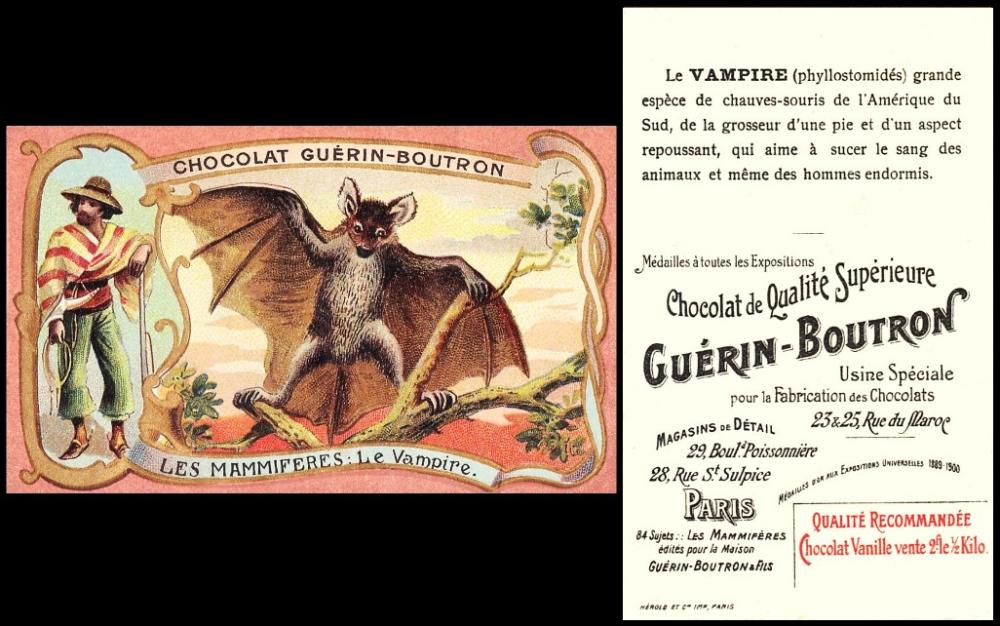
Guerin-Boutron [trade : chocolate : Paris, France] “Les Mammiferes” (19??) Un/84
I have to admit that this is definitely the cutest vampire I have seen in a while. It would be a churlish victim who did not allow him just a little suck.
Though I do find it very disconcerting how large he is compared to the man....
Our event for today celebrates the birth of Abraham "Bram" Stoker, in Dublin, in 1847, and he is chiefly remembered today as the author of “Dracula”, about a man with the ability to turn into a bat and suck the life blood from his victims. The story is fun, but actually most bats do not drink blood; only three species out of almost 1500 do, all of which live in Central and South America, as it says on our card. They use the blood as both food and as water, and their saliva is contains a natural anti-coagulant, to prevent their victim`s blood starting to clot up.
If you are still reading, Dracula was written in 1897, in a very curious way, related through letters and diaries. It definitely adds to the sense of foreboding and strangeness. It remains popular today, and also the inspiration for films, music, television and theatrical performances. Recent discoveries, though, have found that the original working title was not "Dracula" but "The Un-Dead"
There was another string to Mr. Stoker`s bow though, for he was the personal assistant of the actor Henry Irving, and also the business manager of the Lyceum Theatre in London, which was owned by Mr. Irving. The men met in 1876, simply because Mr. Stoker was a theatre critic in his younger years, on an Irish newspaper, and he had reviewed Mr. Irving`s performance of Hamlet at the Theatre Royal in Dublin. Out of the blue, a dinner invitation appeared, from Mr. Irving which was accepted - and this led to their lifetime friendship. In fact it was Mr. Irving who encouraged Mr. Stoker to write more fiction, as well as to submit it to publishers, and you can see that after they met the number of published works increases substantially, sometimes three a year.
Then, in 1906, Mr. Irving died, something which greatly affected Mr. Stoker. He had a series of strokes, despite which he still managed to write a heartfelt tribute, "Personal Reminiscences of Henry Irving". This was published in 1906. Many say that his death, on the 20th of April 1912, was from a mixture of grief and overwork, though it is written on his death certificate as Locomotor Ataxia, something which has led to many theories that cannot now be proved.
At the time of his death he was tinkering with the idea of writing a follow up to Dracula, but it was just fragments. These were collected together by his widow and published two years after. They had discussed such a thing, and he had made her the custodian of all his literary works. In the 1920s she was rather shocked to see that a film with a very similar theme had been released in Germany. In fact she may never have known of it at all if not for a letter, which told her of its existence, and also showed her a programme that stated it to have been adapted from Bram Stoker`s Dracula". She sued, and won the case. The film was F.W. Murnau`s "Nosferatu".
After this she put in place a system that prevented the story being used in any film. This was only broken when she allowed Universal Studios to produce a film of it with Bela Lugosi in 1931.
I cannot believe that the first card of Dracula did not appear until 1954. This was issued with Aguila chocolates and I do not know the film from which the picture comes - though the set does tell the story of the movies so perhaps this was to represent the 1931 version with Bela Lugosi. The same film is also featured in the 1961 set by Nu-Cards called "Horror Monster". In fact
The next Dracula film was not released until 1992, and this starred Gary Oldman. Topps produced a set of a hundred cards, called "Bram Stoker`s Dracula", and they were issued the same year. You got ten cards in a packet, which says, on the front "Suggested for Mature Audiences". There was also a promotional set, of sixteen cards, which were issued four at a time, weekly, with a comic, or more properly a graphic novel, called "Bram Stoker`s Dracula".
This week's Cards of the Day...
... are going to hopefully inspire you all that you do not have to give up trips to fairs and meetings as the winter approaches, you just need to move online. Coincidentally, then, we are fast approaching World Online Networking Day, which happens every year on the 30th of October.
Now whilst this is primarily designed to encourage personal and business connections, the internet can also get collectors in touch with each other, wherever they are in the world, and also provide them with a valuable research tool to increase their knowledge about their favourite issuer, theme, or cards.
Saturday, 26th October 2024
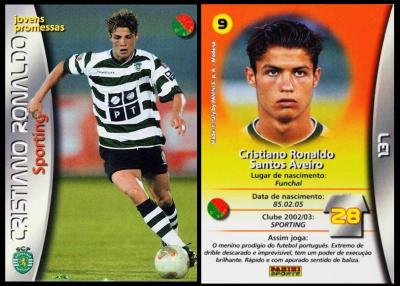
This card is here because on the social media scene this footballer is the most followed, on every site you can think of - and if you add all of his followers together, from every site, there are over a billion of them.
He also has a YouTube site.
This set is an unusual one, and it probably would not have been known about at all in this country had it not been for Cristiano Ronaldo dos Santos Aveiro, who was born in Funchal, Portugal, on the 5th of February 1985.
Now he was not, as many think, called after the Brazilian footballer Ronaldo de Assis Moreira, who became known as Ronaldhino - nor after his countryman Ronaldo Luís Nazario de Lima, who was also known as Ronaldo. Though he did eagerly follow the careers of these men as he grew up. He was actually named after Ronald Reagan, who his father liked very much.
Football was in his blood, and his father worked behind the scenes at the local club to where they lived, not such a big club, with with a long name - Clube de Futebol Andorinha de Santo António. He did lots of different jobs there but primarily was charged with the really important one of making sure that all the strips were clean, and set out in the right place for the respective player to wear.
Cristiano Ronaldo joined their junior team aged just seven, and he was good, good enough that when he was twelve he was signed by Sporting Clube de Portugal`s youth team. They paid £1500 for him, and he had to relocate to Lisbon, away from his family, where the club was based. He was seventeen when he made the main squad, where he is shown on our card, which is said to be his "Rookie" card, though there is another candidate for that, also by Panini, the 2002 series of four hundred and forty three "Futebol" Stickers.
His first game for the senior team must have been a pretty scary one, for it was the UEFA Champions League qualifier. However this turned out to be better than he thought, and it also changed his life, for when he was seen by the other countries playing in the tournament, he received several offers, including from British teams, to play for them.
The team who won his hand was Manchester United. The transfer fee was a bit different though - it was twelve million pounds. Then, in 2009, he was sold to Real Madrid for eighty million pounds. Nine years later, he was again on the move, to Juventus - for a hundred million. It does not seem to be recorded what Manchester United paid to get him back, in 2021, nor what the Saudi Arabian club of Al Nassr paid - though we do know that he has a guaranteed salary of ninety million euros, and his income, including advertising etc is in some years three times that. However, next year he is out of contract, so we can but wonder where we will see him next.
Sunday, 27th October 2024
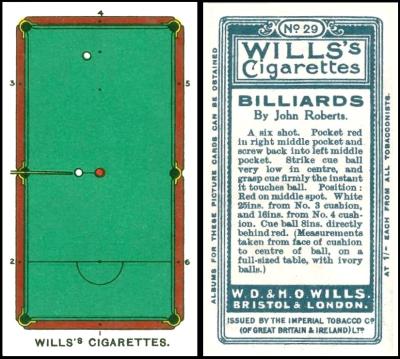
This scan was sent to me after I said it was odd that there were two sets of billiards that looked pretty much the same - and here we have a third!
This was a rather crafty clue, but we were after "Six Degrees" which was the first ever social media. The "six" came from the fact that this is a "six shot", and the "degrees" remind us that getting the ball into the pocket very much depends on the degree on which it is struck by the cue.
There was a brief bit of confusion with John Roberts, the billiards player cited - for there are two.
John Roberts Senior was born on the 12th of June 1823, in Liverpool, but of Welsh stock, and he always insisted he was a Welsh player. He was a carpenter who, by some chance, found himself called in to perform the service of marking for a billiards match. Then there is some fog, as he turns up managing the Union Club Billiards Room in Manchester, without any note of how this came about. He then started to run, or owned the George Hotel in Liverpool, or maybe it was just the billiards room. Then, in 1849 a man called Jonathan Kentfield, who declared himself to be a better player than anyone in the world, and John Roberts challenged him to a contest. This was all set to take place when Mr. Kentfield decided he did not want to play after all, so our man, rather cheekily, started saying that he had beaten the World Champion - and this led to him going off to Australasia in the 1860s on a billiards playing tour, which also seems to have netted him quite a lot of money, some of it, reputedly, on side bets.
However he died on the 27th of March 1893.
More research, though, has discovered that he had three children, including a son who was known as John Roberts Junior, and who was born on the 15th of August 1847, in Liverpool. Some of the confusion about the names seems to have resulted from the fact that in 1870 John Roberts Senior was beaten in a game by William Cook, who went on to call himself the World Champion, but in the same year John Roberts Junior won his first World Professional Title, and many people think, incorrectly, that this was the same person regaining the title. Also, in 1885, it is recorded that John Roberts was part of the squad who rewrote the rules of the game - but actually both father and son were amongst this group.
John Roberts Junior had started playing billiards very young, in the George Hotel billiard room, and it looks like there was some betting involved with that too, perhaps even wagers that this small child could beat any man. also had a pretty lucrative sideline, as he made billiard equipment, anything from a ball to a complete table and set up. Now he won his first contest in 1866, and then also toured the globe, holding exhibition matches and entering contests. And he also fought , and beat, William Cook, in 1873.
The only thing I do not know is how he came to be allied with this set. He died in 1919 aged seventy one, and it was recorded then that he won the Championship almost twenty five years before. So he was not really a household name by the time our set was issued in 1909, though he was featured in Vanity Fair on the 25th of May 1905, as a cartoon by Sir Leslie Ward, which is titled "The Champion of 1885". Maybe he was therefore on the Wills set of "Vanity Fair", and the connection was made when this set was mooted?
Sadly this set is very scantly described in our original Wills reference books, simply :
49. 50. BILLIARDS by John Roberts. Fronts lithographed in colour ; backs in blue grey with descriptive text. Home issue 1909.
And if you thought this short, our World Tobacco Issues Indexes have just :
BILLIARDS. Sm. Nd. (50)
We get the month of issue from the list which was printed in the Wills` "Works Magazine", and reprinted at the front of our reissued Wills book which contained the texts of all the separate ones beneath a hard cover.
Monday, 28th October 2024

So to close out our clue cards, this one ought to have given you a net. When you think about it, tennis and the internet are not so unaligned - especially in research terms. You throw out a request, and it will either be returned over the net, or not. However if we find the right person the information flows back and forth for all the world like the best tennis matches should.
This is an unusual one, because I believed until I was shown this that Chocolat Pupier only did the volumes showing the Continents of the World that we have featured previously, Africa, and Asia.
The cards of this set, in alphabetical order, are
- Alpinisme [mountaineering]
- Automobile [motor car racing]
- Bicyclette [cycling]
- Chasse [hunting]
- Golf
- Luge [tobogganning]
- Motocyclette [motorbiking]
- Natation [diving]
- Pelote Bas [pelota]
- Rugby
- Ski-ing
- Tennis
The odd one out is the Motocyclette, for this shows a man with a woman holding on the pillion, and so it is almost certainly not a sport.
Tuesday, 29th October 2024
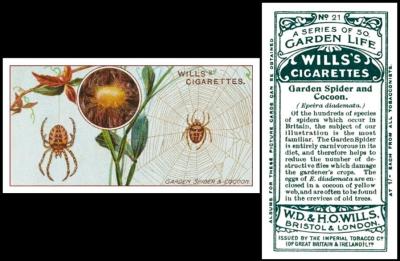
Here we have the spider sitting in the middle of their web. The information they need, or the fly, if you prefer, is waiting, and there are many ways to reach it. It is, however, no use waiting for the fly to come to them.
This is a good analogy for research, and for networking, for sometimes you have to travel down a lot of threads before you find the juicy morsel that is the next link in the chain.
This set is first described in our original Wills reference booklet part III, RB.14, published in 1949. In actual fact it was Parts I and II revised, and part III. It is catalogued as :
69. 50. GARDEN LIFE. Fronts lithographed in colour; backs in grey with descriptive back. Home issue, 1914. Similar series issued by Edwards, Ringer & Bigg and Lambert & Butler (both sets of 25).
We featured the Lambert & Butler version, which was issued in April 1930, as our Card of the Day for the 8th of June, 2023 - whilst the Edwards, Ringer and Bigg version was circulated even longer after, not until 1934.
In our World Tobacco Issues Indexes the entry reads :
GARDEN LIFE. Sm. Nd. (50). See H.449
That H code takes you to the handbook, where the other issuers of this set are listed.
Wednesday, 30th October 2024

Now our younger readers may not remember a time before the internet and all this social media, when researchers either had to buy a lot of books, or go out to the local library. This may have changed, but the library is still as useful, and often allows their members to have free home access to a range of invaluable online research tools.
Here we have a very unusual library indeed, shown here as the Library Khedivial, in Cairo. This was also the Egyptian National Library, first suggested, in 1870, by the ruler of Egypt at that time, Isma'il Pasha, or Ismail the Magnificent. Now at that time he might have been a ruler, but he was not a King, he was known as a Khedive, which is where the name of the library originates. He was also the ruler of Sudan, and he remained in charge of both countries until 1879, when Great Britain and France came along and ousted him. Sadly, this was caused through his own desire to have better links with Europe and Great Britain, and to model the constitution of his country on theirs. In other words he asked for help, and ended up being taken over.
Yet it is him that we have to thank for building the Suez Canal, and making it so successful - plus the growth, and Westernisation of Cairo.
The library was originally sited on the lower floor of his brother`s Palace, at Darb Al Gamamiz, but later moved to .better facilities inside the same, Then the books and other historical artefacts grew too many for the area of the library, and so it was suggested that a new building be designed - however this took five years to complete, and it was not opened until 1904. This building is still there, but is no longer the library, it is a museum. There is a new library, with a separate archives department, which was built in the late 1960s
This set appears in our original World Tobacco Issues Index under the issues of Scerri, Malta - the heading for which says "Cards inscribed "John Scerri", "Scerri`s Cigarette Factory", "Scerri`s Cigarettes", or brand issues inscribed "Black Spot Cigarettes", "Galata and Senator Cigarettes". Issued 1920 - 40." However our set quite clearly states "Scerries Cigarettes", a permutation which is not included in that list. Our set is described as :
INTERESTING PLACES OF THE WORLD. Sm. 60 x 40. Black and white. Nd. (52) ... S32-7
In our updated World Tobacco Issues Index there is still no mention of "Scerries". However the text remains the same, only the code has altered, to S147-375
Friday, 1st November 2024
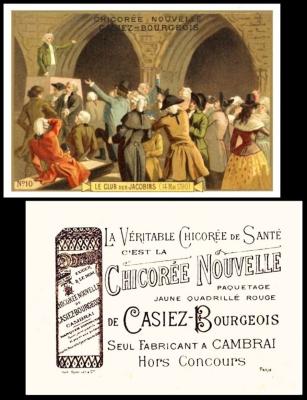
This card is here to represent a meeting, a gathering of like minded individuals, either, as shown here, in person, or online, through zoom or skype, which can be just as fun - and also has the benefit of being able to share cards and books from the comfort of your own homes.
The meeting on this card, however, is rather more charged, for it is Le Club des Jacobins, a political group, which was founded in 1789 as the Society of the Friends of the Constitution, then relocated to a former Dominican convent in rue St-Honore, Paris which was known colloquially as The Monastery of the Jacobins. They formed one of many groups at the time of the French Revolution, and its immediate aftermath; they were seen as the most left wing of all, so much so that some of their members left and formed another group, called the Girondins. Despite this, they were directly responsible for the Reign of Terror, which saw many prominent right wingers and members of the former government sent to their deaths by guillotine.
Now this picture was used on many cards by many makers, and you can even find it with a printed back that tells the story of the club. However all of these appear to have the same number, 10, to bottom left. I do not know how many in the set there were, or the year is was issued - if you do, please tell.
I am now told that card number 1 shows the Opening of the Estates General on May 5, 1789, which makes it possible that this set is not the story of France at all, but the story of the French Revolution. Will investigate this asap
So I ran out of time this week, what with the interference of my continually running nose, my coughing and my general muzzy headed-ness - to say nothing of trying to stop nipper from barking at every firework, though I have to say that he was wagging his tail as he leapt in the air. Then there was the fact that because I had the music on it did lead to quite a lot of very distracting, and even more croaky, singing. Or what passes for singing, anyway.
Anyway I came back in on Saturday morning and completed the final Diary Date of Bram Stoker, and the final Card of the Day for this week, which I completely forgot to write any text for at all.
I also think that the germs are on their way out, so hopefully next week will run more smoothly....
Thanks for coming along, and for being patient. Everything gets done in the end. I will try to return to the index this weekend, which is slightly stymied by my writing a checklist of the A & B.C. Gum "Footballer" cards, and also by trying to sort out why they are in totally the wrong order in our reference books. When that`s done I will celebrate with a banner on the home page....
See you all next week!
